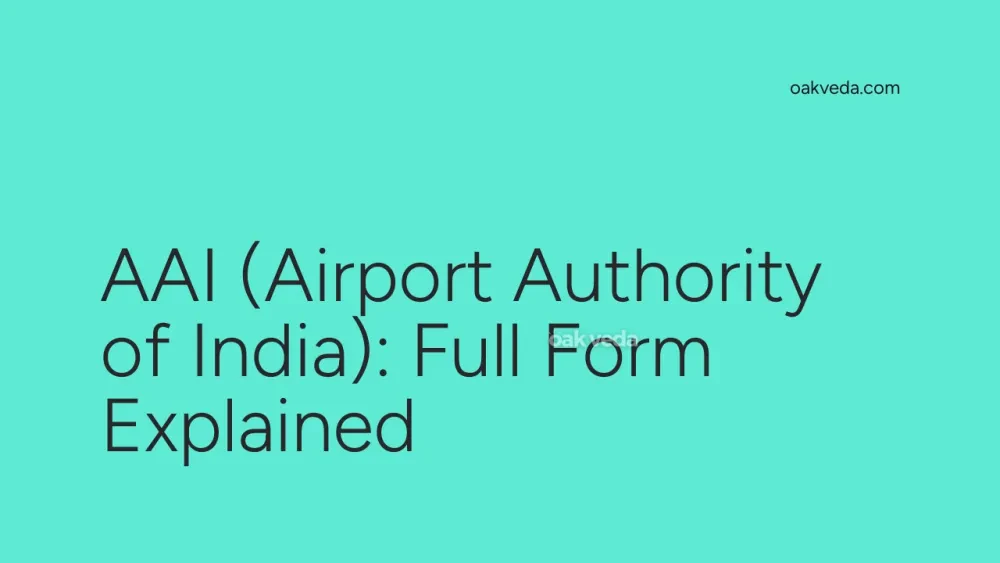
What is the Full Form of AAI?
The full form of AAI is Airport Authority of India. This organization plays a crucial role in the development and management of civil aviation infrastructure in India.
What is Airport Authority of India?
The Airport Authority of India (AAI) is a statutory body operating under the Ministry of Civil Aviation, Government of India. It is responsible for creating, upgrading, maintaining, and managing civil aviation infrastructure throughout the country.
Origin and Development of Airport Authority of India
The AAI's history dates back to 1972 when the International Airports Authority of India (IAAI) was established. In April 1995, the government merged IAAI with the National Airports Authority (NAA) through an Act of Parliament, forming the present-day Airport Authority of India.
How does Airport Authority of India work?
AAI functions as the primary civil aviation infrastructure developer and operator in India. It manages a vast network of airports, including:
- 24 international airports
- 103 domestic airports
- 10 customs airports
- 23 civilian enclaves at military airfields
The organization works closely with various stakeholders, including airlines, government agencies, and private entities, to ensure smooth operations and continuous improvement of aviation facilities.
Functions of Airport Authority of India
The AAI has a wide range of responsibilities, including:
- Airport development and management
- Air traffic management
- Aeronautical communication services
- Navigation aids calibration
- Security management
- Cargo handling
- Passenger facilities
- Airport rescue and firefighting services
One of AAI's critical functions is the calibration of navigation equipment for various aviation entities, including the Indian Air Force, Indian Coast Guard, Indian Navy, and private airfields across the nation.
Applications of Airport Authority of India
The AAI's work has far-reaching applications in various aspects of civil aviation:
-
Infrastructure Development: AAI continuously works on upgrading existing airports and developing new ones to meet growing passenger demands.
-
Air Safety: Through its air traffic management and navigation services, AAI ensures the safety of millions of passengers traveling through Indian airspace.
-
Economic Growth: By facilitating efficient air transport, AAI contributes significantly to India's economic development and tourism sector.
-
Technology Integration: AAI implements cutting-edge technologies to enhance airport operations and passenger experience.
Features of Airport Authority of India
Some notable features of the AAI include:
- Extensive Network: AAI manages 137 airports across India, making it one of the largest airport operators in the world.
- Technological Advancement: The organization completed its first phase of technology demonstration framework in February 2008, showcasing its commitment to innovation.
- Training Facilities: AAI operates several training centers to ensure a skilled workforce in the aviation sector.
Benefits of Airport Authority of India
The existence and efficient functioning of AAI bring numerous benefits:
- Improved air connectivity across India
- Enhanced passenger experience at airports
- Boost to regional economic development
- Standardization of airport operations and safety measures
- Promotion of India as a global aviation hub
Limitations or Challenges of Airport Authority of India
Despite its successes, AAI faces several challenges:
- Rapid growth in air traffic, putting pressure on existing infrastructure
- Balancing modernization with environmental concerns
- Competition from privatized airports in major cities
- Need for continuous technological upgradation
- Managing diverse geographical and climatic conditions across India
Future Developments in Airport Authority of India Technology
AAI is continuously working on technological advancements to improve its services:
- Implementation of satellite-based navigation systems
- Adoption of artificial intelligence for air traffic management
- Development of "smart airports" with IoT integration
- Enhanced cybersecurity measures for critical aviation systems
- Exploration of sustainable and eco-friendly airport technologies
FAQs on AAI Full Form
-
What does AAI stand for in aviation? AAI stands for Airport Authority of India in the aviation context.
-
How many airports does AAI manage? AAI manages a total of 137 airports across India.
-
When was AAI established? AAI was established in April 1995 through the merger of IAAI and NAA.
-
What are the main training centers of AAI? AAI operates five main training centers:
- Civil Aviation Training College (CATC), Allahabad
- National Institute of Aviation Management and Research (NIAMAR), Delhi
- National Institute of Aviation Training and Management (NIATAM), Gondia
- Fire Training Centers (FTC) in Kolkata and Delhi
- Hyderabad Training Centre (HTC), Hyderabad
-
Is AAI responsible for military airports? While AAI primarily manages civil aviation infrastructure, it also operates 23 civilian enclaves at military airfields.
In conclusion, the Airport Authority of India (AAI) plays a vital role in shaping India's aviation landscape. As the country's air traffic continues to grow, AAI's efforts in infrastructure development, technological innovation, and safety management will be crucial in positioning India as a global aviation powerhouse.
You may be interested in:

